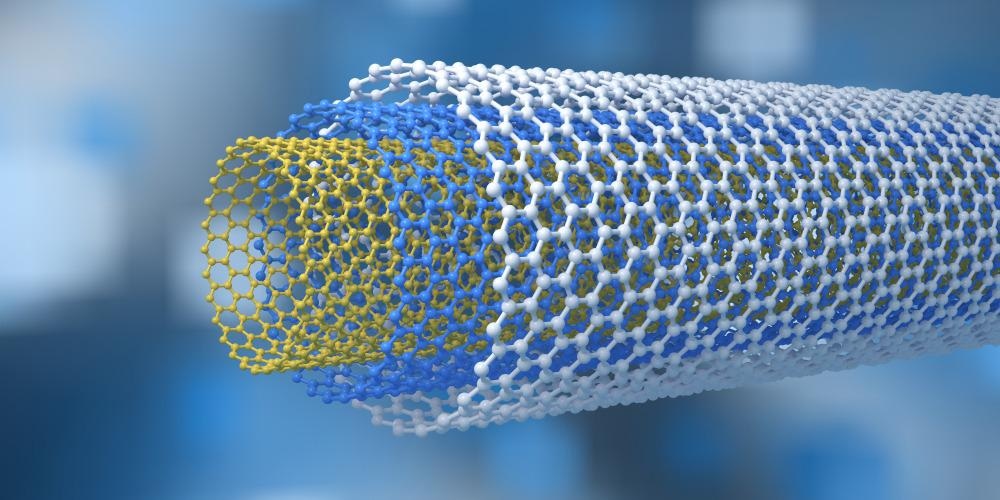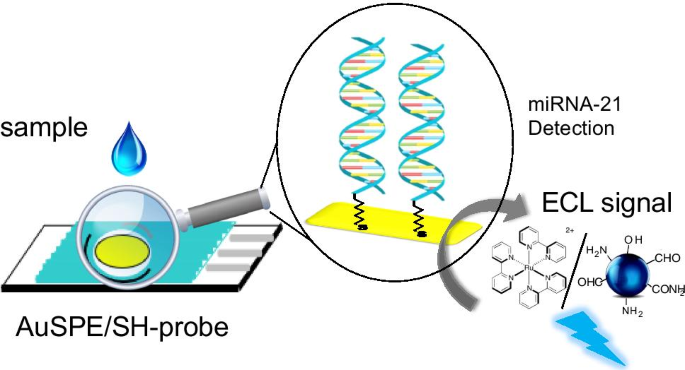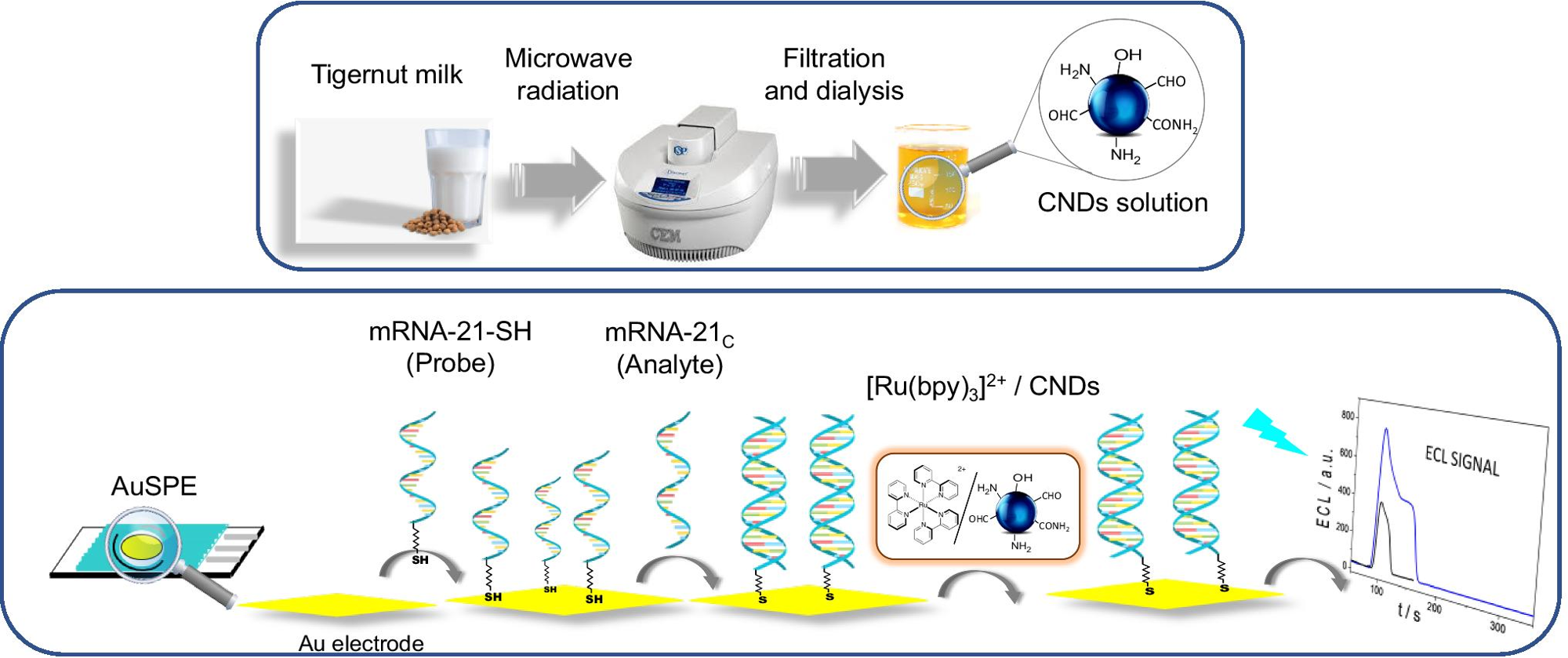Carbon nanomaterials, such as graphene, carbon nanodots, carbon nanotubes, crystalline, and diamond, all display exceptional electrochemical properties, which has led to them being considered for a wide range of different applications. Carbon nanodots (CNDs) in particular have caught the attention of a group of researchers at the Autonomous University of Madrid, Spain who have been using CNDs for testing their effectivity for the detection of miRNA-21, published in the journal Microchimica Acta.

Study: Carbon nanodot–based electrogenerated chemiluminescence biosensor for miRNA-21 detection. Image Credit: ustas7777777/Shutterstock.com
CNDs have been the subject of recent active research and employed in various applications, including biosensing: “In this context, they have been combined with electrochemiluminescence, leading to a new range of possibilities in the field of biosensing,” says Dr. Tania García Meniola, co-author and assistant professor at the Autonomous University of Madrid.

Graphical abstract. Image Credit: Gutiérrez-Gálvez, L et al., Microchimica Acta
To produce the CNDs the team applied an environmentally friendly chemistry-based synthesis using tiger nut milk as a natural precursor which demonstrates excellent properties as a co-reactant for the development of an [Ru(bpy)3]2+/ECL DNA biosensor. The [Ru(bpy)3]2+/CNDs system was employed for the first time to identify the specific sequence of a biomarker associated with breast cancer, miRNA-21. The Madrid team translated this method in an attempt to detect miRNA-21 in serum samples from heart failure patients.
miRNA-21
miRNA-21 belongs to a class of mammalian microRNAs (miRNAs) which are single-stranded molecules around 18-25 nucleotides in length that regulate gene expression. Dysregulated miRNAs have been linked with Alzheimer’s disease, cardiovascular disease, and various cancers, meaning they could be effectively used as biomarkers for early diagnosis.
Notably, miRNA-21 is affiliated with cancer-promoting ‘oncomiRs,’ identified as one of the most frequently upregulated miRNAs in solid tumors. The majority of the targets of miRNA-21 are tumor suppressors, and as a result, it is associated with a wide variety of cancers, including breast, lung, liver, brain, pancreas, and prostate.
Therefore, using miRNA-21 as a biomarker and target for cancer treatments could potentially improve the outcome for cancer patients. However, the Madrid-based researchers were keen on developing a biosensor for the detection of cardiovascular diseases as increased miRNA-21 levels are typically found in the fibroblast of the failing heart.
miRNAs are attractive biomarkers of response to cardiovascular diseases therapy given their stability, tissue-specific expression patterns, and secretion into bodily fluids
Dr. Tania García Meniola, co-author and assistant professor, the Autonomous University of Madrid
Cardiovascular Diseases
According to the WHO, cardiovascular diseases are the leading cause of death globally. The majority of cardiovascular diseases can be prevented or managed by changing behavioral patterns related to smoking, drinking and diet. Therefore it is crucial to identify those at risk as early as possible in order to implement the relevant therapies and medical treatment.
Therefore, using miRNA-21 as a biomarker for cardiovascular diseases has drawn the attention of the biomedical community leading to the research and development of various miRNA sensing methods such as optical and electrochemical sensing methods.

Steps of the friendly environmental chemistry procedure for CNDs synthesis and schematic representation of the DNA biosensor development: probe immobilization, hybridization with the analyte and ECL detection using [Ru(bpy)3]2+/CNDs system. Image Credit: Gutiérrez-Gálvez, L et al., Microchimica Acta
However, existing methods tend to be time- and labor-intensive which demonstrates the need for a rapid biosensing process for early diagnosis of cardiovascular diseases.
Carbon-Nanodots-Based Sensors
Carbon nanodots belong to a class of carbon nanomaterials less than 10nm in size. First discovered in 2004 during the purification of single-walled carbon nanotubes via preparative electrophoresis.
They have been the cause of much excitement and curiosity in various fields due to their exceptional water solubility, chemical inertness, low toxicity, ease of use, and resistance to photobleaching.
The Madrid team was able to synthesize the CNDs with relative ease using non-toxic solvents and natural products, such as tiger nut milk. Additionally, the biosensor proposed for the given application does not require a complex manufacturing procedure.
The resultant method is highly sensitive which facilitates rapid, direct, and simple trace biomarker detection in the serum of heart failure patients. The team applied TEM microscopy to characterize the effectiveness of the CND-based biosensors and further corroborated results using FTIR- and X-ray photoelectron spectroscopy.
Based on their results the team then developed an electrochemiluminescent (ECL) DNA biosensor for the sensitive detection of miRNA-21. The team then put the ECL DNA biosensor through various testing methods for the detection of miRNA-21 in spiked human serum samples and samples taken from heart failure patients.
“We can conclude that the biosensor developed can detect a miRNA-21 sequence directly in clinical human serum samples from heart failure patients without any previous amplification process,” García Meniola stated.
This study has paved the way for developing new environmentally friendly approaches for both the synthesis of CNDs but also the development of novel biosensors for the detection of miRNA-21. Furthermore, this rapid, detection method could boost the chances of cardiovascular disease patient survival.
References:
Gutiérrez-Gálvez, L., García-Mendiola, T., Gutiérrez-Sánchez, C. et al. Carbon nanodot–based electrogenerated chemiluminescence biosensor for miRNA-21 detection. Microchim Acta 188, 398 (2021). https://link.springer.com/article/10.1007/s00604-021-05038-y
World Health Organisation, ‘Cardiovascular Diseases (CVDs)’. [https://www.who.int/news-room/fact-sheets/detail/cardiovascular-diseases-(cvds), accessed November 2021]
Disclaimer: The views expressed here are those of the author expressed in their private capacity and do not necessarily represent the views of AZoM.com Limited T/A AZoNetwork the owner and operator of this website. This disclaimer forms part of the Terms and conditions of use of this website.